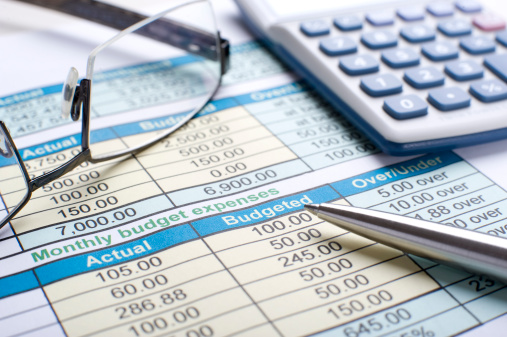
If you have created an estimated monthly budget for your new household after a divorce, know that it will likely change down the road. You may discover after a few months that your spending estimates were unrealistic in some areas while other areas of spending were surprising or unexpected. Here are some tips for projecting your expenses realistically into the future.
Plan for car purchases.
Even if you don’t have a car payment now, you’ll need to replace your car at some point. Consider including a figure in your projected expenses for “car savings.” If you usually keep a car for eight to 10 years and think you’ll spend about $25,000 on a new vehicle, save $260 a month to buy a newer car for cash when the time comes. This means no new car payment, but you’ll have a new vehicle! If you purchase cars more often, factor in the sale or trade-in of your existing car when determining how much to save.
Keep up with car maintenance.
The older the car you have, the more money you should set aside for unexpected repairs as well as maintenance. Maintenance could include oil changes, replacing tires, fixing brakes, tune-ups and other recommended inspections. Regular maintenance will help your car last longer too.
Escrow for home repairs.
A good rule of thumb for home maintenance costs is to escrow 1 to 2 percent of the value of your home each year. A home valued at $300,000, for example, could have annual maintenance costs of $3,000 to $6,000. Costs will be on the higher end for older homes or maintenance you will hire out.
Maintenance could include:
- Replacing the roof, siding or windows
- Caring for lawn and garden, landscaping, drainage
- Fixing and replacing appliances
- Repairs to plumbing or electrical
- Cleaning and replacing carpets
- Painting
- Pool maintenance
- Small maintenance for light bulbs, furnace filters, etc.
You might not need the full annual budget for maintenance every year, but you may need more than the budget in other years.
Start a holiday savings account.
December gift giving, let alone birthday and anniversary gifting, are often missed when budgeting. Consider the gifts you give, the decorating costs and entertaining you host as part of a holiday savings account. This is one area that, once budgeted, people often decide to scale down in future years. However, if it’s a priority for you, you’ll have cash to enjoy it instead of worries about the bills later!
Vacations should be planned with cash.
If you routinely take one family vacation a year or take trips to visit friends and family, add these expenses to your monthly budget and put away cash to cover costs that include airfare, car rentals, lodging, meals, touring and shopping.
Don’t forget to budget for “big box” spending.
People often create a projected budget for groceries or school shopping expenses, but an easier way to budget is to create a “big box” category to cover shopping at stores like Wal-Mart, Target, Costco or other department/membership stores. If you find yourself shopping at these stores at least twice a month, budget for the trips and bring cash.
These are just a few of the ways you can project your future expenses and plan ahead. Other categories to consider include: health care, debt payments, charitable giving, and entertainment. Adjust your amounts as you start to see a pattern month to month, and you’ll have a clearer picture of your cash flow forecast!
 Being a single parent demands so much of a person’s time and energy that taking care of longer-term financial concerns often take a back seat. So many single parents face financial restrictions that make it seem they are constantly on a financial tightrope. Getting off that tightrope and onto solid financial ground should be a priority for every single parent. Finding solid financial ground starts with determining your financial goals and monthly cash flow.
Determine your financial goals
The first step on the path to a more secure financial future is to determine your financial goals. Your financial goals should include short-term, medium-term and long-term goals. Short-term goals may be to reduce spending and not rely on credit cards to make it to the next paycheck. Medium-term goals could be paying off your credit card(s) and creating an emergency fund. Long-term goals may be saving for your children’s college expenses and retirement.
Figure out your cash flow
All of your financial goals require one thing – saving money. To do so, you need to figure out how much you spend and then create a budget that incorporates saving. Tracking your spending can be pretty easy these days with online account aggregators like Mint.com. To better understand your spending habits when using credit cards, you may need to go old school and save the receipts to review your purchases. This is particularly helpful if much of your shopping happens at Walmart, Target or Costco, where your shopping cart could include groceries, video games and clothes. One way or another, figure out how much of your spending is essential and how much is unnecessary spur of the moment buys. Create a budget that accurately matches your essential spending and replaces most of your unnecessary spending with savings.
Be mindful of not only what you buy, but also how you buy it. Using high interest credit cards are an impediment to meeting your financial goals. Paying off high interest credit cards is a financial goal that improves the odds of meeting your other financial goals.
Save the tax-free way
Tax-deferred investment accounts such as Investment Retirement Accounts (IRAs) for retirement and college-funding accounts, such as 529 accounts, are a good way to meet those long-term goals. These accounts often can be opened with a couple hundred dollars. Setting up automatic monthly contributions from your bank account to these accounts can be done for amounts as low as $25. Both types of accounts grow without being taxed until the money is withdrawn. For 529 accounts, there will be no taxes if the withdrawals are spent on qualifying college expenses.
Figuring out your budget shouldn’t be a chore done after the kids are in bed. It should be a family project. Developing good financial habits that lead to meeting financial goals is an essential skill that all parents should share with their children.
Being a single parent demands so much of a person’s time and energy that taking care of longer-term financial concerns often take a back seat. So many single parents face financial restrictions that make it seem they are constantly on a financial tightrope. Getting off that tightrope and onto solid financial ground should be a priority for every single parent. Finding solid financial ground starts with determining your financial goals and monthly cash flow.
Determine your financial goals
The first step on the path to a more secure financial future is to determine your financial goals. Your financial goals should include short-term, medium-term and long-term goals. Short-term goals may be to reduce spending and not rely on credit cards to make it to the next paycheck. Medium-term goals could be paying off your credit card(s) and creating an emergency fund. Long-term goals may be saving for your children’s college expenses and retirement.
Figure out your cash flow
All of your financial goals require one thing – saving money. To do so, you need to figure out how much you spend and then create a budget that incorporates saving. Tracking your spending can be pretty easy these days with online account aggregators like Mint.com. To better understand your spending habits when using credit cards, you may need to go old school and save the receipts to review your purchases. This is particularly helpful if much of your shopping happens at Walmart, Target or Costco, where your shopping cart could include groceries, video games and clothes. One way or another, figure out how much of your spending is essential and how much is unnecessary spur of the moment buys. Create a budget that accurately matches your essential spending and replaces most of your unnecessary spending with savings.
Be mindful of not only what you buy, but also how you buy it. Using high interest credit cards are an impediment to meeting your financial goals. Paying off high interest credit cards is a financial goal that improves the odds of meeting your other financial goals.
Save the tax-free way
Tax-deferred investment accounts such as Investment Retirement Accounts (IRAs) for retirement and college-funding accounts, such as 529 accounts, are a good way to meet those long-term goals. These accounts often can be opened with a couple hundred dollars. Setting up automatic monthly contributions from your bank account to these accounts can be done for amounts as low as $25. Both types of accounts grow without being taxed until the money is withdrawn. For 529 accounts, there will be no taxes if the withdrawals are spent on qualifying college expenses.
Figuring out your budget shouldn’t be a chore done after the kids are in bed. It should be a family project. Developing good financial habits that lead to meeting financial goals is an essential skill that all parents should share with their children.  Being a single parent demands so much of a person’s time and energy that taking care of longer-term financial concerns often take a back seat. So many single parents face financial restrictions that make it seem they are constantly on a financial tightrope. Getting off that tightrope and onto solid financial ground should be a priority for every single parent. Finding solid financial ground starts with determining your financial goals and monthly cash flow.
Determine your financial goals
The first step on the path to a more secure financial future is to determine your financial goals. Your financial goals should include short-term, medium-term and long-term goals. Short-term goals may be to reduce spending and not rely on credit cards to make it to the next paycheck. Medium-term goals could be paying off your credit card(s) and creating an emergency fund. Long-term goals may be saving for your children’s college expenses and retirement.
Figure out your cash flow
All of your financial goals require one thing – saving money. To do so, you need to figure out how much you spend and then create a budget that incorporates saving. Tracking your spending can be pretty easy these days with online account aggregators like Mint.com. To better understand your spending habits when using credit cards, you may need to go old school and save the receipts to review your purchases. This is particularly helpful if much of your shopping happens at Walmart, Target or Costco, where your shopping cart could include groceries, video games and clothes. One way or another, figure out how much of your spending is essential and how much is unnecessary spur of the moment buys. Create a budget that accurately matches your essential spending and replaces most of your unnecessary spending with savings.
Be mindful of not only what you buy, but also how you buy it. Using high interest credit cards are an impediment to meeting your financial goals. Paying off high interest credit cards is a financial goal that improves the odds of meeting your other financial goals.
Save the tax-free way
Tax-deferred investment accounts such as Investment Retirement Accounts (IRAs) for retirement and college-funding accounts, such as 529 accounts, are a good way to meet those long-term goals. These accounts often can be opened with a couple hundred dollars. Setting up automatic monthly contributions from your bank account to these accounts can be done for amounts as low as $25. Both types of accounts grow without being taxed until the money is withdrawn. For 529 accounts, there will be no taxes if the withdrawals are spent on qualifying college expenses.
Figuring out your budget shouldn’t be a chore done after the kids are in bed. It should be a family project. Developing good financial habits that lead to meeting financial goals is an essential skill that all parents should share with their children.
Being a single parent demands so much of a person’s time and energy that taking care of longer-term financial concerns often take a back seat. So many single parents face financial restrictions that make it seem they are constantly on a financial tightrope. Getting off that tightrope and onto solid financial ground should be a priority for every single parent. Finding solid financial ground starts with determining your financial goals and monthly cash flow.
Determine your financial goals
The first step on the path to a more secure financial future is to determine your financial goals. Your financial goals should include short-term, medium-term and long-term goals. Short-term goals may be to reduce spending and not rely on credit cards to make it to the next paycheck. Medium-term goals could be paying off your credit card(s) and creating an emergency fund. Long-term goals may be saving for your children’s college expenses and retirement.
Figure out your cash flow
All of your financial goals require one thing – saving money. To do so, you need to figure out how much you spend and then create a budget that incorporates saving. Tracking your spending can be pretty easy these days with online account aggregators like Mint.com. To better understand your spending habits when using credit cards, you may need to go old school and save the receipts to review your purchases. This is particularly helpful if much of your shopping happens at Walmart, Target or Costco, where your shopping cart could include groceries, video games and clothes. One way or another, figure out how much of your spending is essential and how much is unnecessary spur of the moment buys. Create a budget that accurately matches your essential spending and replaces most of your unnecessary spending with savings.
Be mindful of not only what you buy, but also how you buy it. Using high interest credit cards are an impediment to meeting your financial goals. Paying off high interest credit cards is a financial goal that improves the odds of meeting your other financial goals.
Save the tax-free way
Tax-deferred investment accounts such as Investment Retirement Accounts (IRAs) for retirement and college-funding accounts, such as 529 accounts, are a good way to meet those long-term goals. These accounts often can be opened with a couple hundred dollars. Setting up automatic monthly contributions from your bank account to these accounts can be done for amounts as low as $25. Both types of accounts grow without being taxed until the money is withdrawn. For 529 accounts, there will be no taxes if the withdrawals are spent on qualifying college expenses.
Figuring out your budget shouldn’t be a chore done after the kids are in bed. It should be a family project. Developing good financial habits that lead to meeting financial goals is an essential skill that all parents should share with their children. 



